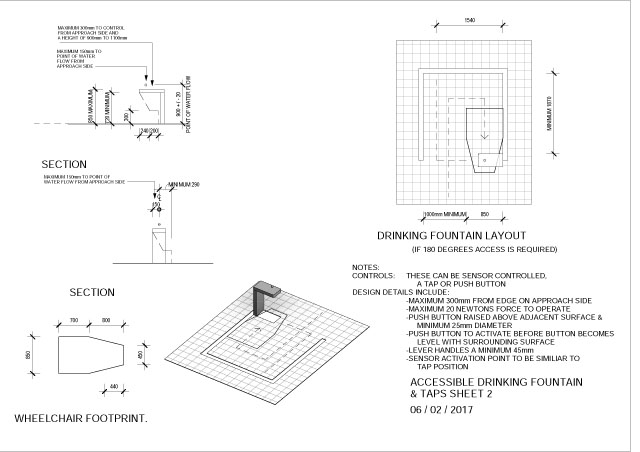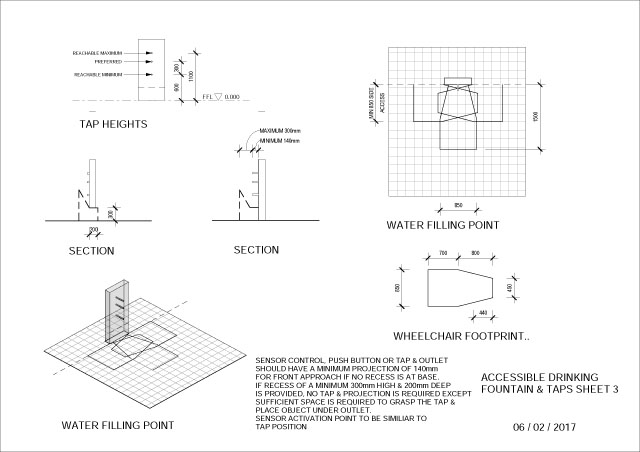1. APPLICATION
Provide accessible drinking fountains where required.
2. DESIGN CONSIDERATIONS
The Design Guide contains criteria for elements which are beyond the scope of the National Construction Code (NCC) and the Premises Standards.
Placement
Located adjacent to and accessible from an access way and locate so the user does not impede movement along the access way.
Circulation
Provide space to access, use, turn around if required and exit the area. Circulation should preferably permit access from either side or front. AS1428.1 Figure 5 requires a clear space of 2070mm x 1540mm in direction of travel to turns 180o. However, as there is clear space under the drinking fountain the depth may be reduced to 1870mm. Circulation space also needs to provide a minimum clear passage past the drinking fountain of 1000mm.
Height
The critical issue is to enable a user to drink from about 900mm above floor/ground level and centred on the wheelchair position. Water supply can come from any direction but should not land or splash onto the user and excess water must drain away. Clear access under should be to AS1428.1 Figure 45.
Controls
These can be a manual control or sensor operated. The location as discussed below is where the manual operation occurs or the point that activates the sensor. Controls need to be within 300mm from leading edge on the approach side. Manual controls require a lever handle a minimum 45mm long or a minimum 25mm diameter pushbutton control that is activated before the button becomes level with the surrounding surface at a maximum force of 20N. If approach is from front or one side only then controls must be centred, if approach is from both sides controls can be offset but must remain a maximum 300mm set back and within wheelchair footprint.
Drinking fountain taps
These also can be manual operation or sensor operated. Taps or sensor operator position should be in the reach range of 600mm to 1100mm with 900mm the preferred height. Access can be from the side or front. There needs to be a minimum clear space under of 300mm for front approach or the tap and handle to project a minimum 140mm. Clear side access is required for side approach. If provided as a sink or similar in or above a bench then the requirements of an accessible sink at a tea point apply as per other design guides.
NOTE 1: For people with limited upper limb function or one upper limb only a sensor operation or a tap with continuous flow is better.
NOTE 2: Drainage of excess water needs to be considered.
Design
All corners to have a minimum radius of 5mm vertical to vertical and rounded on vertical to horizontal. The drinking fountain is to deliver water at maximum 45º Celsius as per NCC Volume 3 in all weather conditions. If water within the fountain may reach this temperature then some relief, valve or other design feature needs to be considered.
3. REFERENCES
AS1428.1 – 2009 - Design for Access and Mobility Part 1: General Requirement for Access – New Building Work incorporating amendment No 1 2010.
AS1428.2 – 1992 - Design for Access and Mobility - Enhanced and additional requirements - Buildings and facilities.
Acumen Access Design Guide ‘Accessible tea point ’ published by the Australian Institute of Architects.
4. DRAWINGS
Sheet 1
Note - Click on image to download.
Sheet 2
Note - Click on image to download.
Sheet 3
Note - Click on image to download.
NOTE 1: The NCC Volume 3 (Plumbing Code of Australia) refers to drinking fountains as 'beverage dispensers'.
NOTE 2: Manual override of any electrical units or battery power is desirable.
Disclaimer
This content is provided by the Australian Institute of Architects for reference purposes and as general guidance. It does not take into account specific circumstances and should not be relied on in that way. It is not legal, financial, insurance, or other advice and you should seek independent verification or advice before relying on this content in circumstances where loss or damage may result. The Institute endeavours to publish content that is accurate at the time it is published, but does not accept responsibility for content that may or has become inaccurate over time. Using this website and content is subject to the Acumen User Licence.



